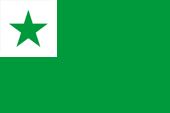Esperanto-Flagge |
|
|
|
| Übersicht – Contents: | |
Esperanto-Flagge |
|
|
|
| Übersicht – Contents: | |
| Erklärung: | Explanation: |
| Esperanto ist eine von Ludwik Lejzer Zamenhof im Jahr 1887 geschaffene internationale Plansprache, die weltweit verbreitet ist. Man schätzt bis zu zwei Millionen Sprecher. Die Esperantisten haben als gemeinsames Symbol eine Flagge. | Esperanto
is one by Ludwik Zamenhof Lejzer in 1887 created international auxiliary
language, which is distributed worldwide. It is estimated up to two million
speakers. The Esperantists have a flag as a common symbol. |
| Quelle/Source, nach/by: Wikipedia (D) | |
| Für mehr Infos hier klicken → www.esperanto.de ← For more info click here | |
Flagge – Flag: |
|
 |
Esperanto-Flagge – Esperanto Flag, Seitenverhältnis – ratio = 2:3, Quelle/Source, nach/by: Wikipedia (D) |
Bedeutung/Ursprung der Flagge – Meaning/Origin of the Flag: |
|
| Das Wort „Esperanto“ heißt „Der Hoffende“. Es lag nahe, dass man als Flaggenfarbe Grün gewählt hat, in Europa und Nordamerika die Farbe der Hoffnung. Der Stern ist laut Ludwik Lejzer Zamenhof ohne Bedeutung. Allerdings wird die Flagge gerade wegen des Sterns von einigen Esperantisten abgelehnt, weil er allzu leicht mit Kommunismus, Anarchismus, der US-Armee oder gar dem Islam in Verbindung gebracht werden könnte. | The word "Esperanto" means "The Hoper". It was obvious that they have chosen green as the flags colour, because it is in Europe and North America the color of hope. The star has no meaning, according to Ludwik Lejzer Zamenhof. However, the flag is rejected by some Esperantists precisely because of the star, because it is to easily associated with communism, anarchism, the U.S. Army or even Islam. |
| Quelle/Source, nach/by: Wikipedia (D) | |